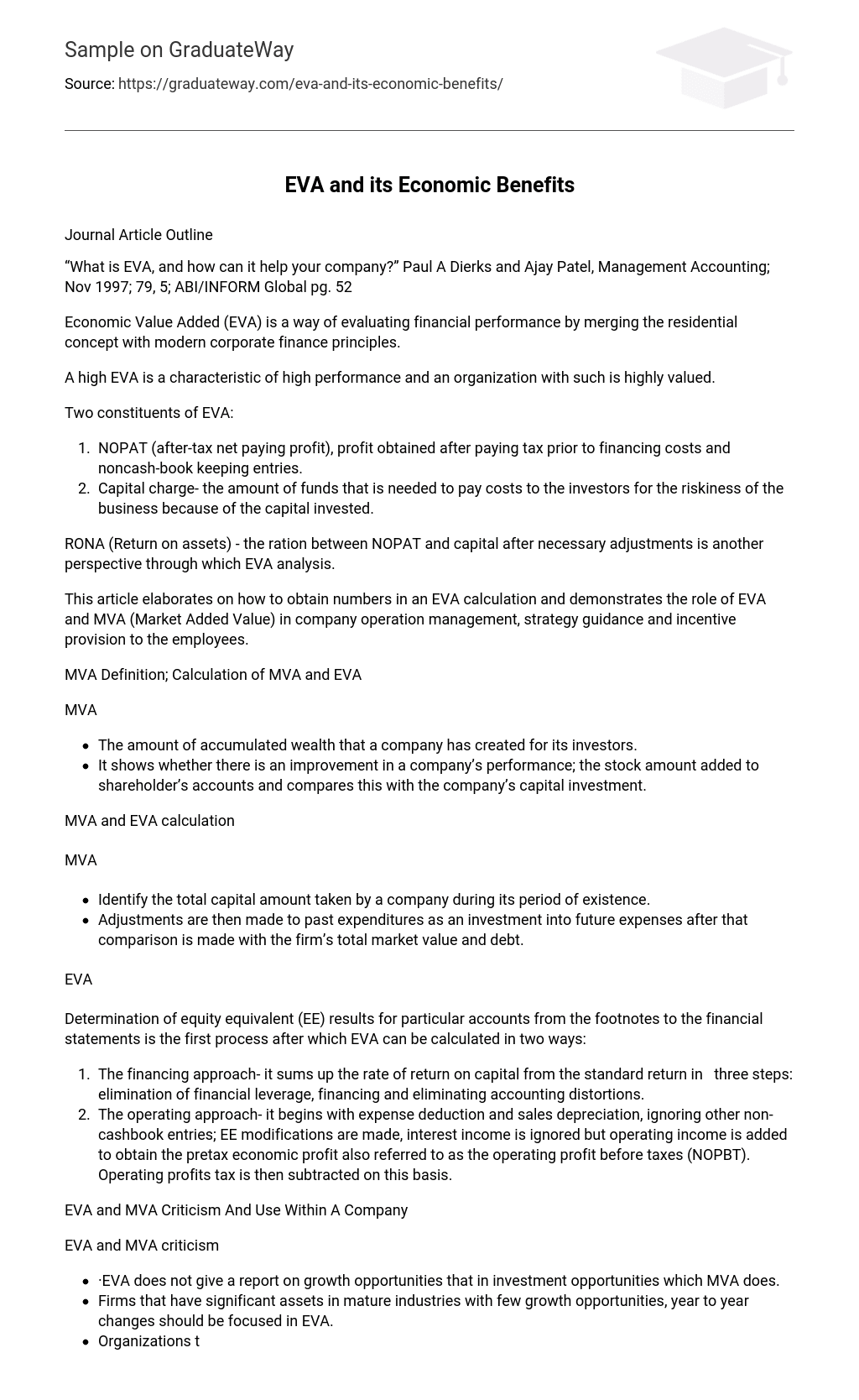Journal Article Outline
“What is EVA, and how can it help your company?” Paul A Dierks and Ajay Patel, Management Accounting; Nov 1997; 79, 5; ABI/INFORM Global pg. 52
Economic Value Added (EVA) is a way of evaluating financial performance by merging the residential concept with modern corporate finance principles.
A high EVA is a characteristic of high performance and an organization with such is highly valued.
Two constituents of EVA:
- NOPAT (after-tax net paying profit), profit obtained after paying tax prior to financing costs and noncash-book keeping entries.
- Capital charge- the amount of funds that is needed to pay costs to the investors for the riskiness of the business because of the capital invested.
RONA (Return on assets) – the ration between NOPAT and capital after necessary adjustments is another perspective through which EVA analysis.
This article elaborates on how to obtain numbers in an EVA calculation and demonstrates the role of EVA and MVA (Market Added Value) in company operation management, strategy guidance and incentive provision to the employees.
MVA Definition; Calculation of MVA and EVA
MVA
- The amount of accumulated wealth that a company has created for its investors.
- It shows whether there is an improvement in a company’s performance; the stock amount added to shareholder’s accounts and compares this with the company’s capital investment.
MVA and EVA calculation
MVA
- Identify the total capital amount taken by a company during its period of existence.
- Adjustments are then made to past expenditures as an investment into future expenses after that comparison is made with the firm’s total market value and debt.
EVA
Determination of equity equivalent (EE) results for particular accounts from the footnotes to the financial statements is the first process after which EVA can be calculated in two ways:
- The financing approach- it sums up the rate of return on capital from the standard return in three steps: elimination of financial leverage, financing and eliminating accounting distortions.
- The operating approach- it begins with expense deduction and sales depreciation, ignoring other non-cashbook entries; EE modifications are made, interest income is ignored but operating income is added to obtain the pretax economic profit also referred to as the operating profit before taxes (NOPBT). Operating profits tax is then subtracted on this basis.
EVA and MVA Criticism And Use Within A Company
EVA and MVA criticism
- ·EVA does not give a report on growth opportunities that in investment opportunities which MVA does.
- Firms that have significant assets in mature industries with few growth opportunities, year to year changes should be focused in EVA.
- Organizations that have few assets but with considerable growth opportunities, focus should be on the present value of expected future EVA.
- MVA should be used to capture growth opportunities in a company since it is constructed off the market’s value of an organization’s securities and so it reflects a market’s future expectation of opportunities in the firm.
Other performance metrics
- Net present value (NPV), CFROI and RI.CFROI (cash flow return on investment); CFROI measures the investment’s return.
EVA and MVA use within a company
EVA is a financial management system whose focal point is to create shareholder value.
Two benefits out of focusing on EVA growth:
- Increase in investor’s wealth.
- Elimination or reduced interferences.
EVA institutes a common language for making long term decisions, resolving budget issues, organizational and managerial units’ performance evaluation; and value creating potential measure.
EVA in Company Management
Using EVA to facilitate management of the company
- Incase of unavailability in stock price measure, the value added measures will be used in the firm’s activities thus creating more emphasis on the operating profit needed to justify capital expenditures.
- Three basic means of raising a company’s EVA
- Raising profit levels without raising the amount of capital spent
- Using less capital
- Investing in high capital-return projects
Benefits of EVA incentive plans
- An EVA based incentive plan is a process of empowerment to the employees to be entrepreneurs and think and act as business owners.
- Revising the compensation system to focus on creating value ensures a sustained continued interest in EVA.
- Increasing the inside ownership of the firm’s stock is one way through which EVA can successfully be used to improve a company’s MVA.
- Fosters teamwork with a long-term perspective.
Implementing EVA
- Requires much time of planning by internal and external financial and compensation experts due to its intensiveness and extensiveness.
- A serious commitment of the board of directors and a senior executive is required to use the outlined measures to manage the business.
- Massive education and communication effort is necessary for transition to value-added performance.
Reference
- Patel, A., & Dierks, A. P., (1997): What is EVA and how can it help your company? Management Accounting. Retrieved on 20th February, 2009 from: http://benchiang19.com/eva.pdf





